Pueblo to Parkdale – The Morning of Jun 21, 2001
The whole thing started Wednesday night when JB Bowers of Pueblo, CO, posted to the Rio Grande list that he had a reliable rumor of a UP train working past Parkdale, CO, on the old Tennessee Pass mainline the next day. Quick history lesson, for those not familiar with Colorado railroading with the Union Pacific: In late 1997, UP shifted all normal through traffic off the Tennessee Pass route due to its high operating cost. Past that point, locals continued to run to Gypsum on the west side and Malta (just south of Leadville) on the east side, but nothing actually went over the pass itself. UP has considered everything between these points embargoed and enforced this with turned-over rails at both of these points. About two years ago, the mining traffic at Malta dried up, and after the last regular Malta Turn, the end of track was moved back to just west of Parkdale, where it remains today. The line is physically intact, though, and for various reasons a rare train still does sometimes pass onto the out-of-service main. This was to be one of those trains, hopefully… Time to call my boss, tell him I think I’m going to take a day off tomorrow.
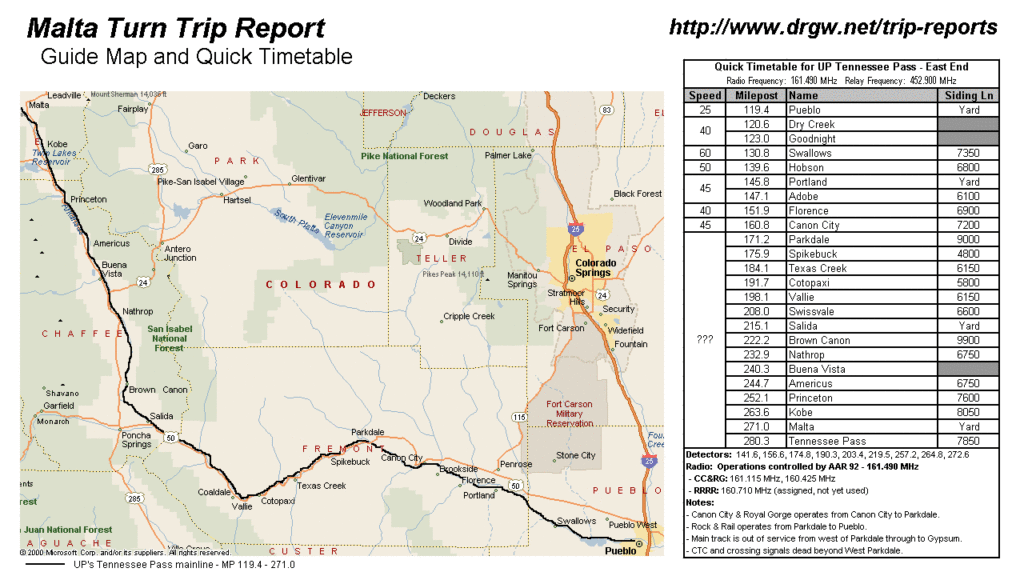
Before I go further, I should mention that two railroads jointly operate parts of the main below Parkdale, CO. Rock and Rail, owned by a quarry operation in Parkdale, moves most of their product out by rail, and operates from Parkdale over to the Pueblo Yard, where they either exercise trackage rights to Colorado Springs or they interchange with the Union Pacific for shipment elsewhere. They regularly store their equipment on the main, and apparently this is what tipped of this friend of JB’s – UP asked them to remove their equipment from the mainline so that a train could proceed up the line. In addition, the Canon City & Royal Gorge (pronouned Canyon City) operates a passenger operation through the Royal Gorge for twelve miles west of Canon City, using two ex-CNW F-units repainted in a scheme that looks roughly Rio Grande-esque (though not exact – Photo #2, from last summer). UP, however, retained overhead operating rights on this line when it was sold, so they are free to run trains such as these without any problems whatsoever. In addition, I believe UP Dispatcher 80 still controls traffic and CTC over this segment, so ultimately they’re still in the picture.
As a new feature I plan on including with trip reports, I’ve made the first image a map and a quick timetable of the area in question – Pueblo up the Arkansas River to Malta, just south of Leadville. I’m hoping that this helps anybody unfamiliar with the region (Photo #1).
The initial report I got was that the crew was called for 0700h, meaning I needed be awake at 0530h to get down to Pueblo on time. Late on the night of the 20th, I checked the UP trace and noticed that DRGW 5356 had been assigned to a Pueblo-Pueblo run, and was expected to leave at 0600h. Just in case, I decided to play it safe and be there in plenty of time – 0545h, meaning I had to be awake at 0400h. Ugh – we all know how much I love early mornings. (Hint: I’m seldom to work before 0900h.) Just time to throw the laptop, camera, scanner, Altamont Press timetable in the bag, put the batteries on to charge, and head off to bed – it’s going to be an early one…
Tennessee Pass rumors come and go – rumors of trains show up semi-regularly, few ever come to pass. However, this was quickly turning into a rumor that had motive power assigned to it, and consequently my excitement level was climbing with every minute. When I only had five hours to put towards sleep ahead of a very long day, anything keeping me awake is a very, very bad thing. Finally I think I fell asleep, or my wife knocked me out to shut me up around 2330h. Let me tell you, it seemed like about five minutes passed and my alarm was waking me up at 0400h. Ugh, I hate mornings, and I really hate getting up before the sun.
Fortunately, there’s no exhaustion that a litre of Mountain Dew and the chance to see Rio Grande power on Tennessee Pass won’t fix. Well, at least the chance – I don’t think caffeine or sugar even affect me anymore. I loaded up everything into the truck, grabbed my DeLorme topo maps, and headed down to the local convenience store to feed both my truck and myself. Fortunately I eat cheaper than the truck does these days… Regardless, I was Pueblo-bound by 0430h, plenty of time even if the crew was early and things got rolling.
Arrive Pueblo 0530h. Discover the reason I haven’t heard any radio traffic since leaving Colorado Springs isn’t because there wasn’t any, but rather because my scanner batteries were dead and I didn’t bring the lighter-plug adapter. That’s item #1 forgotten for the day. So, another stop at another convenience store and $12 later I had a powered scanner again. Why is it every time I go out on a major trip I manage to do this?
A quick run around the town revealed nothing really moving, and I couldn’t see any strings of gons sitting in the yard to be taken up the hill. The whole TP mainline is currently being cleaned up due to the settlement of a suit claiming that SP was negligent in cleaning up their M-o-W mess and consequently it was endangering the ecology of the area (ties in the river, etc…) There’s a Herzog unit doing the work, but it requires a constent supply of empty gons in which to put junk after it picks it up. All of the locals up into the embargoed section of the line in the past year have been to deliver and switch these gons, and I had no reason to assume otherwise. My natural conclusion was that the power would probably be headed out light, pick up some loaded gons, and bring them back down to Pueblo. I was actually expecting a set of four axle power to get the job, but I couldn’t figure out what other job 5356 might be assigned to if it wasn’t assigned to this TP train.
Parked at the UP engine facilities were various bits of big AC power, along with the three D&RGW tunnel motors off the previous night’s rock train (Mesa, CO to Pueblo, CO, for interchange with Rock and Rail), and a fourth T-2 buried in behind an SD70M – presumably DRGW 5356. Down in the yard itself, BNSF was busily switching cars and pushing trains in and out, but the UP side showed little to no activity. 0600h and 0630h came and went, nothing happened. Five small units sat in the yard, seemingly lifeless from my perch high on a hillside to the west of the facility. I was seriously beginning to worry that the rumor was just a rumor, or they’d left early in the morning and I’d missed them entirely. With no action in sight, I set off to McDonalds to sit, read the paper, and eat something resembling breakfast.
About 0740h, I headed out again in hopes of seeing something move. Again, nothing apparently changed, except there were some signs of life in the yard. For one, an empty coal train had pulled in and stopped just short of the switches that would let it out on the Tennessee Pass line going west out of the yard (Photo #3). Also, a pair of units (one SP, one UP) had been fired up and was starting to perform switching duties, etc. My initial assumption was that they would be putting a train together and taking it up, since they looked like fairly small units and it was the only readily visible activity. So much for having 5356 around, I guess.
After an additional amount of touring around looking for additional signs of movement, I finally just returned to the bridges at the west exit to the yard. As I came up on the gravel pullout at the west end, I noticed another truck sitting there, and another guy out wandering around with a camera. Another crazy person out at this time of the morning… It did give me a bit of reassurance that I either hadn’t missed the train or else there were just two of us standing around waiting on a train that would never come. So after passing across the bridge to get a better look down the yard tracks, I crossed back over and struck up a conversation. The other railfan in question was none other than JB Bowers himself, the man who started this whole thing. We stood, talked, waited, talked, waited, watched the switching geeps disappear deep into the yard, and eventually, after almost an hour, I’d honestly decided that nothing was going to happen. Deep down I still wanted to believe there would be a train reasonably soon, but it was already almost 0830h, and there was no sign of anything even remotely close to leaving. Therefore, I did the one thing assured to bring out the train – I decided to leave.
No sooner had I gotten across the bridge than I noticed headlights far down in the yard on an empty track. All I could see was that the lead unit was an SD70M, and the only one I knew of was coupled to a Rio Grande T-2. So I waited, and waited, and after what seemed like fifteen minutes, the two units finally got close enough I could see the second unit was indeed 5356. Note to self: make the universe think you’re leaving, and dumb luck will make the train will show up. Back over the bridge to tell JBB not to give up, the train’s on its way…
After another small eternity of watching them collect cars in the yard, they finally announced on the radio that they were ready to go, and pulled up to the switch to exit the yard. What I couldn’t understand was the consist they’d collected behind them – 75 steel rotary-dump coal cars. While there is a generating station in Canon City, it still didn’t make sense because the cars were empty and they were rotary dump – the CC station can only accept bottom dump cars. At this point I was thoroughly confused – what the heck do they plan to do with the hoppers? As the crewman was standing at the switch, he asked the crew on UP 4091 why they weren’t moving forward. As it turns out, while applying train brakes to stop for the switch, one of the cars had dynamited and the whole thing went into emergency. They were in the process of pumping the air back up, though, and it appeared to be holding. I was hoping, for the crew’s sake and mine, that this wasn’t a sign of things to come – otherwise, it was going to be a long, slow day. Within minutes, though, everything was back to normal and the crew pulled through the west end of the yard and kept right on going. At last, the local we’d been waiting for was a reality. (Photo #4) For reference – I had absolutely no luck getting a decent photo here. The light this time of day was completely wrong for any shot I could think of using, but without a photo to start the trip, how would I ever get this report written?
While there are a small amount of photo opportunities between Pueblo and Portland, none are really all that great, and none are well suited to a westbound train in the morning. All of them would have amounted to pictures of the sun with a black blotch eclipsing part of it. So I headed on to Portland, a cement plant and limestone quarry twenty-five miles from Pueblo. Upon arrival, I still found the lighting to be unusable, so on up the road I went to Florence.
Just outside of Florence the tracks go under the road (Colorado 120) on an old concrete bridge at approximately MP 148. While not great, the lighting was much better than Portland, and I could at least get some elevation above the train. After waiting what seemed an eternity and once again almost giving up on the assumption he’d beaten me to the bridge, I finally heard a detector go off at MP 141.6. Thank goodness, as it’s a very steep embankment and there aren’t any shoulders on the road, so a railfan is left to brace himself against sliding downhill – was really grinding my toes into the front of my boots. As a note, my Altamont timetable doesn’t list a detector at this location, but I definitely heard one. Reported speed: 22 mph. Well, that would certainly explain why this was taking so long… Within a few minutes, JB showed up, and a few minutes after him, so did the train. (Photos #5, 6) As an added benefit, UP Dispatcher 80 asked the 4091 how far up the intended to go – and the magical answer of “Malta” came back. Also, I heard verification from the track inspection truck that the rail at Parkdale had been reinstalled and was ready for service. Whoohoo! Clear to Leadville – this was going to be a very good day if the weather held up.
At this point, I could hear over the scanner that the CCRG’s train was just pulling in to Canon City, and was about to start unloading passengers. The 4091’s crew was notified not to come through Canon until they’d been cleared by the CCRG’s crew that unloading was complete and the passengers were all clear of the platform. Understandable, most of those tourists were probably oblivious to the fact that there was going to be a westbound freight today. It was also good for JB and me, who both got stuck behind a road mowing crew on the way in, and consequently lost quite a bit of time on the train. No matter, though, really, as we both made it down to the crossing west of the CC&RG’s depot before he was even authorized to come through.
Due to the lack of time, I didn’t get a chance to get a decent shot of UP4091 passing the Gorge train sitting in the siding. All that I took were obscured by objects or by shadows, caused by the numerous trees, bridges, and structures around the area. Thanks to the wonders of digital editing, however, I’m able to bring you Photo #7. It’s a bit blurry, but that’s mainly due to hot air moving around in the atmosphere, and I can only correct for so much… Once he had emerged, though, the sun had finally climbed high enough in the sky to give a railfan a chance, hence the two photos of its passing through Canon City (Photos #8, 9). After that, he disappeared down into the Gorge and I proceeded up and around to Parkdale on US 50. There really aren’t any good ways to easily access the Gorge – the park around the bridge is too expensive just for the impressive shot of looking off the bridge and down on the passing freight.
At Parkdale, UP 4091 would step off the end of the still-used track and onto the long-unused embargoed section between West Parkdale (technically the end is at MP 171.9, I believe) and Malta.
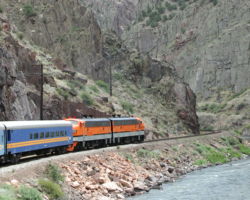
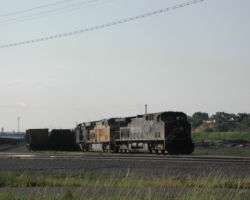
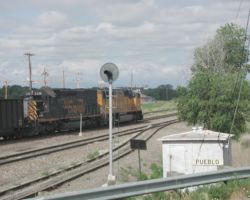
Parkdale to Malta – The Afternoon
As I’d mentioned before, the first shot really available after Canon City is at Parkdale, where the line comes out of the Royal Gorge and rejoins US Hwy. 50 for the trip to Salida. In afternoon light, the shot from the highway bridge looking back down the canyon is impressive, but as it was nearly noon the lighting was entirely wrong. Through this section of the line, there are frequent pull-offs alongside the road for tourists, slow traffic, fishermen, and rafters to use. Some of the developed, more recreation-oriented areas have fees for parking (self serve, honor system only), and I have no idea how well they enforce these. It’s only two bucks, but that’s still more than I want to spend to sit and wait on a photo. Yes, yes, don’t bother pointing out how much each shot costs anyway by the time you figure in equipment, time, effort, fuel, etc… However, I decided to just stick with the usual roadside gravel just west of the West Parkdale switch. It provides a decent view of the official end of active track, and I thought would make a decent photo for the start of the rest of the trip.
Drive, sit, wait, wonder if it passed you, see train, shoot photo. Repeat. Seems to be the general receipe for this trip, and Parkdale was no exception. You’d be amazed the puzzled looks you get from rafters in the Arkansas when they can’t figure out what you’re pointing your camera towards. All they see is a hillside – I see the points end of a CTC installation showing me red over red. As a note, this is also the last working CTC installation on the line going west. Finally, sometime around 1200h, I finally heard horns in the distance and within minutes 4091 showed up and, just as expected, passed right through Parkdale and headed up the line (Photo #10). I believe, if my records are right, this is the first major train beyond this point since 13-Oct-2000.
For the next three hours, I followed this train down through the canyon towards Salida. For the most part, this was a very uneventful trip, composed of driving, stopping, waiting, and photographing the action. The first of these stops, after Parkdale, was somewhere down around Spikebuck (Photo #11). This whole canyon just provides so many opportunities to photograph trains snaking around curves, it’s hard not to try each and every one of them. I promise, I won’t bore you by showing off every curve, and honestly after about the first five I became much more selective.
Somewhere down closer to Texas Creek, I saw another railfan. JB had gone back to Pueblo after Parkdale, and I didn’t recognize this guy or his car. Either way, I didn’t want that shot, so I didn’t slow down for the pullout. However, a bit further up the road when I stopped for a shot looking down on a curve and a cut, the mystery railfan in question pulled up behind me. As it turns out, this was none other than Todd Busse. Finally, at last, I’ve met one of the two from Avon – now if I’d run into Paul B. of MWR one of these days.. (note: PB, of course, moved away from Avon last winter.) I guess it takes a serious breed of railfan to take off on such short notice during the work week to chase a train over what’s now a weed-infested branchline. Good to finally meet you, though, Todd. Oh yes, and the shot from the location in question became Photo #12.
After that encounter, we were both off up the line, and I found my last shot in the lower canyon just beyond Cotopaxi where the canyon makes a bit of a shallow S-curve. (Photo #13-14) From here west, though, the canyon widens out into a small plain, and the track and road separate by a rather large amount. Didn’t matter that much, I was much more interested in getting to the upper narrow bits of canyon just outside of Salida at this point, so I didn’t spend much time looking for shots down between Coaldale and the Red Hill Tunnel (just north of Howard, CO).
As usual, when I don’t follow the train exactly, I miss things. What’s worse is when I forget my scanner’s turned off, I usually miss really big things. In this case, I drove up just past the tunnel and waited for nearly an hour for the train to show up, but didn’t see anything. Finally, just after two, the section truck inspecting the track ahead of the train came through the tunnel, and shortly thereafter Todd showed up. As it would turn out, the crew had been storing the 75 cars they’d been hauling in the Vallie siding, just north of Coaldale. Having my scanner turned down, I’d missed all the fun, and the train was already well underway towards out position at this point.
After catching the light power passing through Red Hill Tunnel (Photo #15 – sorry, again, it’s digitally-enhanced to compensate for no large zoom lens), we both decided it was time for lunch and headed on in to Salida. Even the crew was hungry – they sent a pursuing hyrail truck (though on the road, not on the railway) ahead to round up food and bring it to both the section truck and to the train crew. At this point they realized they were very much pressed for time, as it would be almost 1430h before they made it into Salida.
Despite my better thoughts to avoid fast food, I grabbed a sandwich at KFC and headed on up along Colorado Hwy. 291 in hopes of getting my bearings relative to the train once again. I hate having to depart from the line long enough that it becomes possible for the train to sneak by me. Then when I come back, I never know whether I’m ahead or behind, and even which way I should look. The Tennessee Line provides some useful hints, though, in terms of dirt accumulation in the flangeways at crossings and general rust on the railhead. Fortunately, based on a crossing just north of Salida, I guessed correctly that he hadn’t yet come through, and within a few minutes the two units showed up, just where I assumed they’d be (Photo #16).
In my half-awake state, I’d grabbed the wrong map when I left. DeLorme Topological maps of Utah wouldn’t be much help today… Without the aide of maps, I decided to forgo any effort to find a way into Brown Canyon and just head up to Nathrop to stake out a spot. I’d heard over the radio that there were gons in Nathrop to pick up – two loads and two empties – so I wanted to try and get a few decent switching shots. Unfortunately, the yard at Nathrop is quite far from the closest road I could find at the time, so I was content to sit and watch from afar as the two assembled the four gons sitting there and pulled out with them. For reference, these are for a cleanup project along the Tennessee Pass line being conducted by Herzog (Photo #17). The Herzog cleanup train needs somewhere to put all of the junk it picks up, so UP has been running locals such as this one to place gons to haul the scrap in and out. Two of the gons at Nathrop were full and were to be hauled back to Pueblo, and two were empty, and were to be spotted at Malta for further work.
Soon it was on up the line again – next stop, Buena Vista. It’s clear people are thinking of the TP main as abandoned these days – you should see the looks on peoples’ faces when they realize there’s a train only a few feet away! I actually had one guy pull up and tell me that if I was looking to photograph a train, I’d better just give up and move on because this line was abandoned and it hadn’t seen a train since the late 1990s. Let’s just say he was rather confused and surprised when I asked him what those three headlights visible down the track were, if it wasn’t an oncoming train… I also heard the crew mentioning bits about a car parked too close to the main, and that they were taking extra care while passing it to assure that nothing hit. Since power to any and all signals (including grade crossing signals) is turned off, the crew had to stop before nearly every grade crossing to assure people realized there was a train about to pass. Sure some surprised faces in the local population… A few photos here, with a brewing storm in the background (Photo #18), and then on north to seek out the next location.
The crew decided to drop the two loads in Americus (a siding just north of Buena Vista, and not terribly accessible by all I could tell) before going north to Malta. I’m guessing the logic here was that they didn’t want to have to deal with the cars at Malta, and they thought they could make it this far back before going dead. Unfortunately, due to the inaccessibilty (or at least perceived inaccessibility), I didn’t manage to see the set-out. Instead, I travelled north to Princeton (a siding about 8 miles north of Americus) and hiked down to the west switch. The set-out obviously didn’t take long, at least compared with the leasurely pace of the rest of the day. Perhaps the crew was starting to feel the pressures of the clock working against them, or perhaps things just went smoothly, I don’t really know. Either way, within minutes of climbing down the hill to the west Princeton switch, the train was rounding the corner. (Photo #19)
At this point, there were only twenty miles left into Malta, but the shadows were growing longer and the clouds larger and more troublesome. Definitely late in the day – I’d say around 1730h at this point. At least, thankfully, it was the summer solstace, longest day of the year. Couldn’t have asked for a better day, really, but those clouds had robbed me of some great shots throughout the day. Sure, I still took them, but dealing with a dark subject on a very bright high-altitude background is almost impossible for my camera to deal with. Consequently, only through a great deal of help in the “digital darkroom” are some of the shots even presentable. Just before Granite, there’s a long canyon where the road is high enough to overlook the tracks running through the bottom. What’s turned into my favorite shot for the trip was taken here (Photo #20). Through Granite, through, the light was good, and the passage of the train over the seldom-used roadbed was kicking up a large amount of dirt and dust. (Photo #21)
Cloud shadows became much more of a problem a few miles further up at a location my map indicates only as “Balltown”. The item of note here is a large deck girder bridge that survives with the Rio Grande name on the side, spanning the Arkansas where it’s little more than a large creek. I thought for a second clouding was going to completely blow this shot as well, but seconds before the train was in position the clouds broke open and put light right where I needed it. Being that this was the main shot I’d been thinking about all day, I was glad to have it actually work out. (Photo #20)
Other than a brief stop at Kobe (which yielded a photo you’ll find on the third page), the next stop for us, the railfans, was Malta. Making good time from Kobe to Malta, 4091 and crew wasn’t far behind us, and soon the train arrived at the furthest point west it would be travelling to today (Photo #23). Once in the yard (Photo #24), the crew dropped one gon on the north leg of Malta’s stub wye, and one on the south leg. This part I don’t understand – my understanding is that Herzog units load their collections (ties, tie plates, junk, etc) into gons by pulling up beside them and then using the crane to transfer the junk over. Sitting in this position on the wye, I fail to see how these are of use to anyone, but… Afterwards, with most of the crew on the groud, Todd and I assumed that it was over for the day – it made sense that the crew really did go on at 0700h, and that they’d just all gone dead on the law and would wait at Malta for a relief crew to take the power (and the two gons left at Americus) back to Pueblo.
Just as we were both ready to walk away, however, the nose lights on 5356 came on, and the crew climbed back aboard the unit. No upper headlights, just the nose lights – very interesting. With the severe backlighting and the nose in darkness, it rather looked like a BC Rail SD40-2, except for needing a second set of ditch lights, of course. The crew obviously wasn’t about to go dead, and the two light units set back out for Americus (Photo #25) and, somewhere along the route, no doubt a crew change.
I did continue to follow them back about halfway to Buena Vista, but light eventually ran out. Also, after nearly 16 hours of continuous railfanning, I was ready to head home and crash into bed – not particularly looking forward to the drive home. Since this trip did produce more interesting photos than I was really able to work in, I’ve included a third page with a few of the photos that I was quite fond of, but just didn’t fit into the story for one reason or another. Hope you’ve enjoyed it, and with any luck we’ll be seeing more trains on Tennessee Pass in the future – at least more locals before dismantling, or hopefully a full return to service.
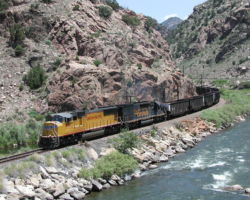
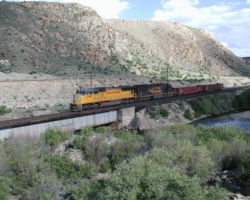
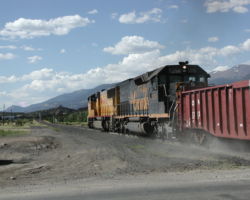
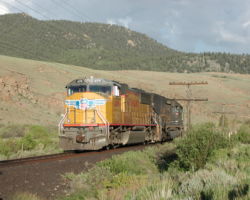
This work is copyright 2024 by Nathan D. Holmes, but all text and images are licensed and reusable under a Creative Commons Attribution-NonCommercial-ShareAlike license. Basically you’re welcome to use any of this as long as it’s not for commercial purposes, you credit me as the source, and you share any derivative works under the same license. I’d encourage others to consider similar licenses for their works.
































